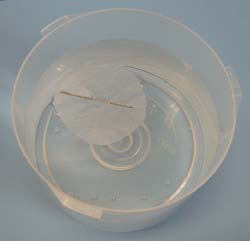Magnetism Experiments
Navigating the Oceans
In these magnetism experiments you will learn how to tell which way is north, east, south, and west using a needle for a compass. Sailing ships were at the mercy of wind currents and storms as they sailed in the open oceans. Prior to modern instruments sailors used magnetism to find their way on the high seas.
Materials
- Sewing needle
- Magnet (horseshoe or bar)
- Wax Paper
- Bowl
- Water
- Scissors
Directions
- You will need a steel sewing needle for these magnetism experiments. Pins used in sewing are often not magnetic.
- Take a magnet and begin stroking one end of the needle with the north end.
- Pull the magnet from the center to the needle to the end
approximately 50 times.
- Reverse the needle and begin stroking it from the center to the end with the opposite end of the magnet, the south end.
- Some magnets are marked with north and south ends. If your magnet is not marked just make sure you stroke the ends of the needle at opposite poles.
- Cut a piece of wax paper out in a circle that is slightly larger than the needle. Slip the needle in and out of the wax paper so it will not fall off. Fill a bowl with water.
- Carefully place the wax paper in the bowl with the needle on top. Make sure your magnet has been put away because it will attract the needle. Watch carefully to see if you needle has been properly magnetized.
- If the needle is properly magnetized the end of the needle you rubbed with the north end of the magnet will point toward magnetic north. This is how sailors used a magnetized needle or some other object to see which direction they were traveling.
Try these magnetism experiments
- Try to magnetize a steel nail,
other needles and float them on a piece of cork.
- Move the magnetized needle, steel nail, etc and see if they always return to the place where one end of the needle points north and the other points south.


Click for More Information and to Order
Science behind the experiment
Earth has a magnetic field around both poles. The magnetic field is similar to a bar magnet with a tilt 11 degrees off of Earth's axis that spins in a circle once every 24 hours that gives us night and day.
The point on the Earth's axis at both the north and south poles is called magnetic north and south. This point on the Earth's surface changes over time. The poles may wander each year more than 5 miles.
More Links to Science Experiments
Physical Science Experiments, Swinging With Galileo Try these fun physical science experiments first done by Galileo. See if you can make things swing on a string by pushing one object to set all the hanging strings in motion.
Plant Experiments, Creating Oxygen Try these fun and easy experiments about plants creating oxygen.
Volcano Science Experiments, Foaming Volcano Watch as your miniature volcano foams over the size of a crater and down the slopes in this fascinating experiment.
Kids Science Experiments, Rubber Band Shoot Out This fun experiment is filled with shooting rubber bands!
Easy Science Experiments Lots of easy experiments for kids of all ages.
Kids Fun Science Find out about science activities, experiments, plate tectonics and much more on this page.
Magnetism Experiments, Navigating the Oceans Do you know how to create a compass using only a needle and magnet? Try this easy experiment and find out!
KIDS FUN Science Bookstore
Check out Myrna Martin's award winning textbooks, e-books, videos and rock sets. The Kids Fun Science Bookstore covers a wide range of earth science topics. Click here to browse.











